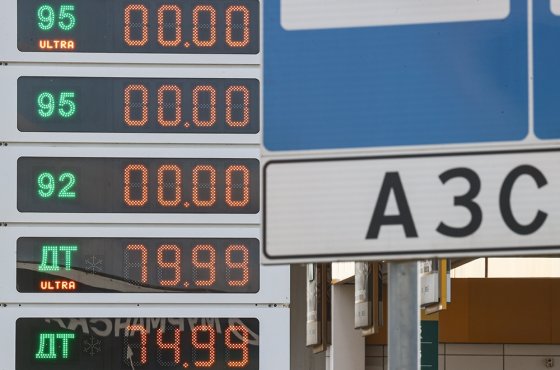However, tranquility seems fleeting; during the same week, the price of diesel fuel (DT) rose by 51 kopecks, with an increase of 1 ruble 47 kopecks (1.7%) over the past four weeks. Since the beginning of the year, diesel prices have surged by 6.1%, exceeding consumer inflation for the same period (5.23%). Gasoline had already experienced a price hike by July, and by November 5, the average increase in gasoline prices had more than doubled the inflation rate (12.1%).
By the end of this year, gasoline prices could set a record for increases since 2019—the year when the price dampener mechanism (subsidies for oil producers from the budget for supplying fuel to the domestic market) was introduced. At that time, the government established a "gentleman's agreement" with oil companies stipulating that retail prices at gas stations should not exceed annual consumer inflation.
Last year, gasoline prices averaged 1.6% higher than the annual consumer inflation, and they seem likely to exceed that figure this year. Since 2019, the government has repeatedly adjusted the parameters of the price dampener, consistently reducing payments to oil companies until this year. During the peak of the gasoline crisis, a decision was made to temporarily suspend the elimination of dampener payments (when prices exceed set thresholds in the market), which was a concession to the industry. It is probable that this decision, combined with a seasonal decline in demand, affected the market, leading to a halt in the rise of gasoline prices at gas stations.
Now, two main questions arise regarding gasoline that perhaps concern everyone—how long will the market calm last, and can retail gasoline prices decrease by the end of the year? Regarding diesel, there are also two questions of interest: how long will the price continue to rise, and by how much?
The cessation of rising retail gasoline prices was preceded by a drop from historic highs in its market quotations. The AI-92 grade fell by 16.5% in wholesale, while AI-95 decreased by 8.3%. Despite this, the increase in their quotations since the beginning of the year was significant—43.7% for AI-92 and 49.6% for AI-95—implying that relative to those levels, the decrease was minimal.
The primary factor that may influence retail and wholesale fuel prices is the increased production at refineries.
According to Yuri Stankevich, Deputy Chairman of the State Duma’s Energy Committee, the volatility in gasoline market prices could indeed render 2025 unique compared to recent years. This is largely due to extraordinary circumstances in the latter half of the year, including shutdowns at refineries caused by drone attacks. The downward trend in market prices will primarily impact the financial standing of independent gas stations (not owned by major oil companies, accounting for about half of gas stations in Russia). Retail prices at these stations have differed from those of vertically integrated oil companies (VINCs, which handle the entire production cycle from extraction and refining to retail sales) by 10-20 rubles. A decrease in prices at these stations seems logical. This is also a requirement from the Federal Antimonopoly Service (FAS) of Russia, emphasizes Stankevich.
Analyst Sergey Kaufman from Finam notes that independent gas stations may see a slight reduction in gasoline prices as their margins improve. However, noticeable price drops at VINC stations are unlikely. While the situation in the wholesale market has eased somewhat, challenges remain. Additionally, since July, the margins for gasoline sales at gas stations have been negative; thus, stations may need to maintain elevated prices to compensate for previous losses, as the expert mentions.
Dmitry Gusev, Deputy Chairman of the supervisory board at the "Reliable Partner" association and a member of the expert council for the "Gas Station of Russia" competition, argues that retail gasoline prices are unlikely to fall as they are already at the minimum possible level. As long as fuel prices are aligned with inflation, there is little hope for reductions; their increase seems predetermined. Alternatively, one might expect a general deflation in the country, making it a matter for the Central Bank.
From the perspective of Mark Shumilov, an analyst in the resource sectors at Renaissance Capital, the main driver for normalizing gasoline prices will continue to be the restoration of fuel output at refineries after maintenance. Following that, gasoline prices at gas stations may stabilize at more comfortable levels.
The situation for diesel is somewhat different. Kaufman notes that transitioning to winter diesel traditionally poses challenges in Russia, leading to pronounced seasonality in DT price increases. Currently, this seasonal factor is compounded by reduced refining volumes due to attacks on refineries. The expert suggests that price pressure on diesel could remain elevated for another 2 to 2.5 months, forecasting that the year-end increase in diesel prices could be around 8.5-9.5%.
Nonetheless, it can be countered that attacks on refineries mainly impact gasoline production, which has historically been 12-15% higher than domestic market demand in Russia. Diesel production is nearly double the demand in the country, and even the most pessimistic estimates from Western information agencies indicate that less than 30% of our refinery capacities have been affected by drone strikes. Diesel exports to non-producers (traders) are currently temporarily banned, meaning that even now, more diesel is produced than needed for the domestic market. Traditionally, diesel price increases have slowed and then stopped by early December.
Autumn is traditionally a busy season for the diesel market, explains Sergey Tereshkin, CEO of the OPEN OIL MARKET fuel marketplace. The primary consumers of diesel are freight transport, which shifts from summer and transitional diesel to winter diesel towards the end of the year. Therefore, in October and November, market expectations for rising diesel prices are formed, even amidst significant excess capacity in the Russian market. Given recent trends, the price of diesel fuel could increase by about 9% by the end of 2025. This exceeds inflation, which is unlikely to exceed 8% for the year, the expert clarifies.Source: RG.RU




